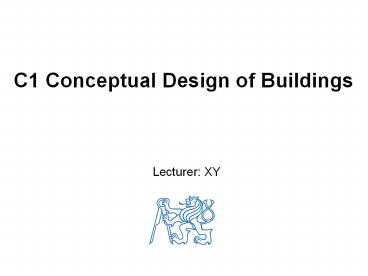C1 Conceptual Design of Buildings - PowerPoint PPT Presentation
Title: C1 Conceptual Design of Buildings
1
C1 Conceptual Design of Buildings
- Lecturer XY
2
List of lectures
- Multi-storey buildings
- Floor slabs, primary and secondary beams
- Joints of floor beams and columns
- Cellular beams, slim floors
- Composite floors
- Steel columns
- Base plates
- Composite beams and columns
- Composite frames
- Frame bracing
- Advanced models for frame bracing
- Design tools
- Conceptual design, repetition
3
Objectives of the lecture
Objectives Multi-storey buildings Purpose Advanta
ges Disadvantages Historical review Examples Lay-o
ut Spatial stiffness Load Floor
structure Conclusions
- Multi-storey buildings
- Purpose, advantages and disadvantages
- Historical review and examples
- Lay-out
- Spatial structural stiffness
- Load
- Floor structure
- Conclusions
4
Multi-storey buildings
- Purpose administration, public, residential,
hotels - Advantages of steel solution large spans,
shallow floors, small dimensions of columns,
speed of erection, lower weight, smaller
footings, ready for re-construction, after the
end of its useful time easy to removing and
re-cycling - Disadvantages higher acquisition costs,
additional fire protection - Tall buildings premium of height
5
Historical review
- 1885 Chicago Home Insurance Building, the
first building with iron columns and 10 storeys - 1899 New York Park Row 119 m, 29 storeys
- 1931 New York Empire State Building 381 m, 102
storeys - 1971 New York WTC 417 m, 110 storeys
- 1974 Chicago Sears 443 m, 110 storeys
- 2004 Taipei 101 509 m, 101 storeys
- 2010 Dubai 828 m (predominantly concrete)
- Under construction New York Freedom Tower 1776
ft (542m), etc.
6
Tallest buildings in the world
7
New York, Empire State 381 m
- Open at 1931
- 102 storeys
- Constructional time 18 months
- Steel riveted structure
- 60 000 t
- Survived crash of B25 Mitchell at 1945
- Iconic for N.Y.
8
New York, World Trade Center 417 m, collapsed 2001
9
Tajvan, Taipei 101
- Open at 2004
- 101 storeys
- 509 m
- Composite steel and concrete megastructure
- Hollow steel columns 2400x3000x80 mm filled by
concrete - Steel 650 t ball as a damper suspended in 88.
storey - Traditional bamboo shape
- Happy number 8
10
Dubai Burj Tower (828 m)
- Main concrete part 586 m
- Upper steel part 130 m
- Steel needle 112 m
- Finished 2009
- Open 2010
- Design Skidmore, Owings and Merrill (U.S.A.)
- Actual name Burj Khalifa Tower
11
Spatial stiffness
12
Stiffened and non-stiffened frames
- Stiffened frames and non-stiffened (hinged)
frames functionality of the system is ensured by
(horizontally) very rigid floor tables - Stiffened frames
- Truss structures cost effective, but disturbing
the lay-out - Rigid frames lesser stiffness, not disturbing
the lay-out - Stiffening walls (concrete or masonry) good for
not too high buildings
13
Load
- according to standards (CSN EN 1991 in Czech
Rep.) and demands of client - permanent commonly the same in all floors
- variable
- imposed load 2 to 5 kN/m2
- wind pressure depends on wind velocity at site,
height of building, aerodynamic properties, - snow depends on conditions at site, for
multi-storey buildings not so important - technical equipment for example heating, air
condition - seismic effects not significant in Czech
Republic
14
Floor structure
- Floor deck with two functions
- to spread the vertical load into primary and
secondary floor beams - to spread the horizontal load into stiffened
frames - System of primary and secondary floor beams
different arrangement, see below, common distance
between primary beams is 2 - 3 m - Hot-rolled I beams preferred
- Bolted joints preferred































